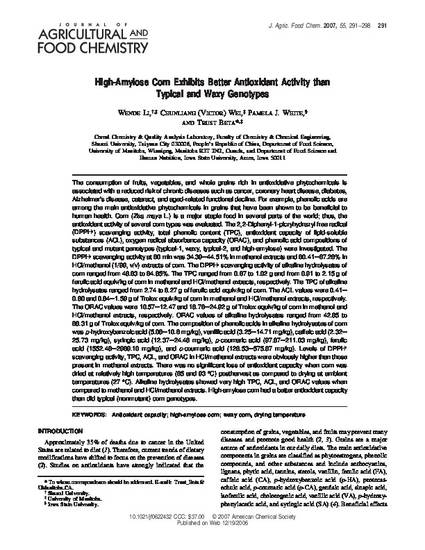
The consumption of fruits, vegetables, and whole grains rich in antioxidative phytochemicals is associated with a reduced risk of chronic diseases such as cancer, coronary heart disease, diabetes, Alzheimer's disease, cataract, and aged-related functional decline. For example, phenolic acids are among the main antioxidative phytochemicals in grains that have been shown to be beneficial to human health. Corn (Zea mays L.) is a major staple food in several parts of the world; thus, the antioxidant activity of several corn types was evaluated. The 2,2-Diphenyl-1-picryhydrazyl free radical (DPPH•) scavenging activity, total phenolic content (TPC), antioxidant capacity of lipid-soluble substances (ACL), oxygen radical absorbance capacity (ORAC), and phenolic acid compositions of typical and mutant genotypes (typical-1, waxy, typical-2, and high-amylose) were investigated. The DPPH• scavenging activity at 60 min was 34.39−44.51% in methanol extracts and 60.41−67.26% in HCl/methanol (1/99, v/v) extracts of corn. The DPPH• scavenging activity of alkaline hydrolysates of corn ranged from 48.63 to 64.85%. The TPC ranged from 0.67 to 1.02 g and from 0.91 to 2.15 g of ferulic acid equiv/kg of corn in methanol and HCl/methanol extracts, respectively. The TPC of alkaline hydrolysates ranged from 2.74 to 6.27 g of ferulic acid equiv/kg of corn. The ACL values were 0.41−0.80 and 0.84−1.59 g of Trolox equiv/kg of corn in methanol and HCl/methanol extracts, respectively. The ORAC values were 10.57−12.47 and 18.76−24.92 g of Trolox equiv/kg of corn in methanol and HCl/methanol extracts, respectively. ORAC values of alkaline hydrolysates ranged from 42.85 to 68.31 g of Trolox equiv/kg of corn. The composition of phenolic acids in alkaline hydrolysates of corn was p-hydroxybenzoic acid (5.08−10.6 mg/kg), vanillic acid (3.25−14.71 mg/kg), caffeic acid (2.32−25.73 mg/kg), syringic acid (12.37−24.48 mg/kg), p-coumaric acid (97.87−211.03 mg/kg), ferulic acid (1552.48−2969.10 mg/kg), and o-coumaric acid (126.53−575.87 mg/kg). Levels of DPPH• scavenging activity, TPC, ACL, and ORAC in HCl/methanol extracts were obviously higher than those present in methanol extracts. There was no significant loss of antioxidant capacity when corn was dried at relatively high temperatures (65 and 93 °C) postharvest as compared to drying at ambient temperatures (27 °C). Alkaline hydrolysates showed very high TPC, ACL, and ORAC values when compared to methanol and HCl/methanol extracts. High-amylose corn had a better antioxidant capacity than did typical (nonmutant) corn genotypes.
Available at: http://works.bepress.com/pamela_white/11/

Posted with permission from Journal of Agricultural and Food Chemistry 55 (2007): 291–298, doi:10.1021/jf0622432. Copyright 2007 American Chemical Society.